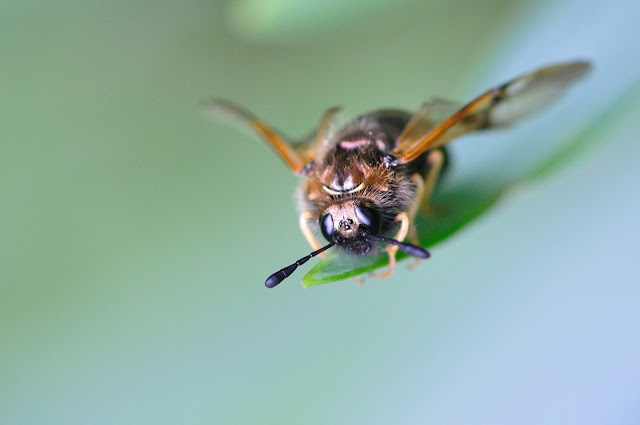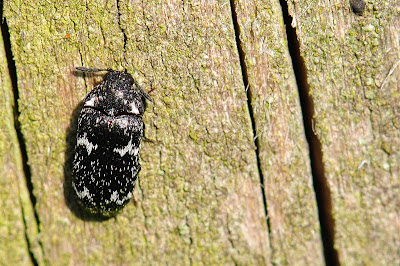Can you see it?
Friday, 31 May 2013
Getting all excited over a black weevil
.JPG) |
| Liophloeus tessulatus, left, typical form, right, form maurus |
 |
| Clytus arietis - The wasp beetle, Shelford Notts, 31.May 2013 |
Monday, 27 May 2013
Another Jumping Spider "Evarcha falcata" plus a couple of nice beetles, Oiceoptoma thoracicum and Rhagium bifasciatum
 |
| Evarcha falcata Sherwood Forest 26th May 2013 |
 |
| Rhagium bifasciatum 26th May 2013 |
.JPG) |
| Oiceoptoma thoracicum - Wellow wood Notts. 26th 2013 |
Also found the very distinctive Silphid carrion beetle Oiceoptoma thoracicum, unlikely to be confused with any other UK beetle. This was a single chap attracted to a pile of Dog faeces at Wellow wood to the east of Sherwood. I once found about 30-40 of these beetles on a dead crow at Lathkill Dale Derbyshire (there is a picture on my flickr site of a pair copulating on the bird) and have also encountered them on stinkhorn fungus. Wellow wood is well worth a visit. I went to look at a rather large patch of Early Purple Orchid. These were nicely in flower but the site has already become a little to shady to allow for a good photograph.
I also attach a photograph of a group of English Longhorn cattle on the Heath. These lot were all particularly young and the middle one was doing a good bit of foot-stomping. Now I'm not usually phased by these beasts but this group of young lads seemed to be behaving with a little more belligerence than normal. So, I chickened out and hopped over the fence to avoid confrontation. Finally I see that BBC springwatch is back on the television, if ever a program brings out the cynic in me its got to be this one. I'm not sure if I can take another owl eating its brother or sister or infra-red badgers doing very little apart from scratching their nether regions. Any rutting stags being filmed? Or am I confusing this with the similar fayre shown in the autumn.
 |
| posse, gang, angry herd, these youngsters were a little too inquisitive for my liking. |
Red Mason Bee Cleptoparasite - Sapyga quinquepunctata
.JPG) |
| Sapyga quinquepunctata - Carlton Notts 27th May 2013 |
Saturday, 25 May 2013
Green Winged Orchid, Sawflies and yet another Salticus.
It's not very often that I can say "I'd rather have been at work than out and about" but Friday was that sort of day. How things can change in the UK. Today Saturday, not too hot but plenty warm enough for a bit of arthropod action. However main quest of the day, off to Woolsthorpe in the Vale of Belvoir to take a look at the Green Winged Orchids (Anacamptis morio). Not a lot to say really, a herb rich meadow with lots of nice flowers of which the orchids are probably the star attraction. However as usual the flowers had to wait, one of the old wooden gates leading into the field held a very healthy population of my Favourites "jumping spiders". It's the eyes that do it for me, it makes them look rather intelligent and the fact that their other six eyes gives them 360 degree vision means they pretty much know your getting close and want to photograph them. However hope you like the pics, one eating a small hoverfly and one hiding in the mark left by a hammered nail. Also photographed is a not too common Sawfly, I think it's Tenthredo temula, but again as with all my sawfly determinations if someone knows better please let me know. Found the Sawfly feeding on Cow Parsley "Anthicus sylvestris" but I observed it successfully ambush and devour a dipteran fly. On a non natural history not I also attach a "macro" photograph of Phantom of the Ruhr", or sometimes named "City of Lincoln" our last airworthy Avro Lancaster.
.JPG) |
| Salticus with Hoverfly meal, Woolsthorpe Leicestershire 25 May 2013 |
.JPG) |
| Salticus at Home. |
 |
| Tenthredo temula, Woolsthorpe Leicestershire 25th May 2013 |
 |
| Lancaster and fighter escort Vale of Belvoir 25th May 2013 |
Tuesday, 21 May 2013
Honeysuckle Sawfly - Zaraea lonicerae
.JPG) |
| Honeysuckle Sawfly Carlton, Notts 21st May 2013 |
 |
| Honeysuckle sawfly - Carlton Notts 21st May 2013 |
PS - I'm no expert on sawflies so if I've made a howler in i.d. then please let me know. And finally, pictures were taken early evening it was also a little dull, I don't use flash so had to increase ISO to 500 to get working light, hence not tip top sharp image. Still you get the picture it's a beautiful thing.
 |
| Sawfly Carlton Notts Garden 21st May 2013 - resting on Flag Iris. |
Monday, 20 May 2013
Couple of Fresh-uns
.JPG) |
| Small Copper Lycaena phlaeas May 19th 2013 |
.JPG) |
| Speckled Wood Parage aegeria Carlton Notts 20th May 2013 |
Trent Valley Reed Beetles - Donacia simplex, vulgaris and clavipes.
Twenty one species of reed beetle are known to occur in the UK, of which 15 occur in the genera Donacia. Of these I have found three species during my ramblings along the Trent Valley, namely Donacia simplex, D. vulgaris and D. clavipes. They are medium sized metallic coloured beetles, usually found near water and all associated with water plants. The most common in Nottinghamshire and along the River Trent is D. simplex. From mid-May through to end of June they can readily be seen feeding mating and just hanging around on Burr Reed. Good spots to find them are the Gravel pits around Holme Pierrepont, along the Banks of the River itself above Stoke Lock whilst good populations exist at Colwick country park where they are pretty common along the old course of the Trent, known locally as Colwick loop. A similar species D. vulgaris can also be found in the same spots, very similar to simplex it can be most easily distinguished by the violet to blue streak, one on both elytra (the hard modified protective wing case). This species like simplex uses Burr reed as the larval food plant. The only other species I have encountered was the nationally scarce reed beetle D. clavipes, I found one of these chaps at Skylarks nature reserve. This beetle feeds on Phragmites australis, "common reed" plentiful at the skylarks site. However further searches have so far proved fruitless.
I also found quite a pretty fly whilst out, the Pond Olive, thought I had a nice photo, but the specimen I photographed was damaged it should have two whip like tails projecting form its rear end. They appear to be missing. Whether it lost these on emergence or lost them to attempted predation I'll never know. Still it's a curious fly and makes a good study.
 |
| Pond Olive "Cloeon dipterum" May 19th Home Pierrpont Notts. |
Tuesday, 7 May 2013
Another Jumping spider on my wall, "Siticus pubescens"
 |
| Jumping Spider, Siticus pubescens - Carlton wall 07/05/2013 |
Anyway enough of bees. When looking at the bees my attention was drawn to the chap in the photograph. He had taken up position behind my bee log in a little gap between the wall and the log. He seemed quite happy with a small shaft of sunlight illuminating him nicely. A rush inside for the camera and what you see is the best of some rather average shots, I think that there was not enough natural light, but it still gives a pleasing effect, give the picture a double click and you can see it a little more clearly.
Siticus pubescens is a rather nice hairy jumping spider, slightly larger than my other wall dweller Salticus scenicus. Described as common and living on walls and fence posts. I have them on both wall and fence in my suburban garden. Still haven't got the extension tubes, but have spent a fair bit on 3 books on British spiders, an EBAY bargain!
Monday, 6 May 2013
Bee's in Flight.
A beautiful day here in Nottinghamshire. My Red Mason bees were active from about 8.00am and built themselves up in to a right mating frenzy by about 10 O'clock. This gave me a chance to try and photograph a few in flight. In the past I've found macro-photography of moving insects all but impossible. However camera fully charged, shutter set for multiple shot standing on a chair so that I could get close to the hole they were investigating and then shoot away. I upped the ISO to give me a bit more shutter speed and stayed focussed on one point hoping that the bees would actually fly into my focus point rather than me chase them around. Hope you like the end result, I'm rather pleased for once. I've uploaded another couple of images on my flickr account, you can access this by clicking the link in the right hand column of this blog.
.JPG) |
| Osmia bicornis Carlton Nottinghamshire 6th May 2013. |
This chap on my finger has got to be my favourite species of Bee, its not rare, it doesn't have anything fancy about other than its stunning colours. Andrena haemorrhoa
.JPG) |
| Andrena haemorrhoa - Holme Pierrepont Nottinghamshire 6th May 2013 |
And finally, more Bees this time a couple of Mason Bees doing what comes naturally, it's either pushing the other one off or it's up to something else, I'll leave that one to you to work out.
.JPG) |
| Osmia bicornis, Carlton Notts, 6th May 2013. |
Sunday, 5 May 2013
Love Darts - Helix aspersa
Garden snails, Helix aspersa, don't need sex they're hermaphrodites, an organism with both male and female reproductive organs. Although self fertilisation can occur they do, at least in my garden, like a bit of gamete swapping, in the form of sperm exchange. However snail courtship like most snail activities is a slow process taking several hours. Preliminary to copulation snails shoot darts (scientific name gypsobelum) at each other. These hard darts are stabbed into the partner prior to mating and are thought to contain hormones that increase the survivability of the sperm that the snail will subsequently pass to its partner. I attach a photograph that clearly show the dart in the side of the right hand snail whilst it also shows the transfer of sperm between one snail and another. Not a lot more to say really other than there's a lot of sex going off in the garden at the moment. End result, each snail produces about 80 large whitish eggs.
Wednesday, 1 May 2013
Dermestid Beetle, Megatoma undata
 |
| Megatoma undata - Shelford Notts 1st May 2013 |
.JPG) |
| Tawny Mining Bee - Shelford 1st May 2013. |
Subscribe to:
Posts (Atom)
.JPG)
.JPG)

